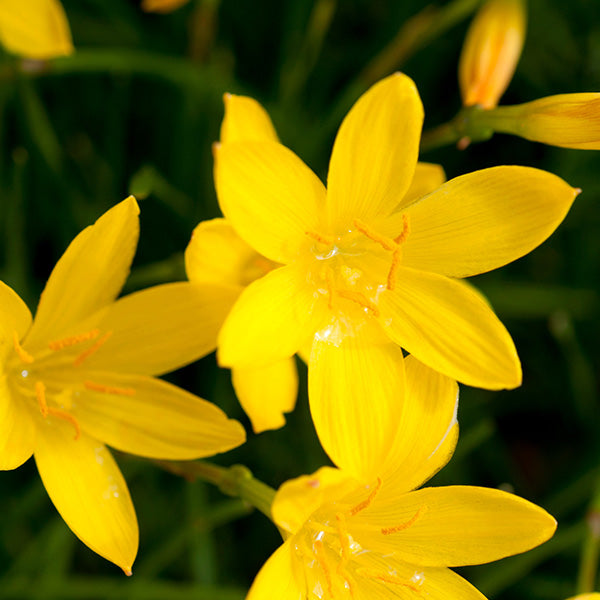



- SOWING
TIMEFebruary to March and June to September
- Sowing
DistancePlant to plant - 6 to 8 inches
- Fruit
WeightN/A
- Fruit
ShapeN/A
- Days to
maturity40 to 60 days
- Details
- How to sow
- Reviews
Introducing bright yellow rain lily bulbs that bring natural sunshine into your garden. These exquisite light bulbs have a cheerful yellow bloom that easily brightens up any outdoor space. Petite and gracefully shaped, yellow rain lily bulbs are perfect for borders, containers, or as a pop of colour in rock gardens. These hardy perennials grow in a wide variety of soil types and are easy to care for, making them ideal for both novice and experienced gardeners. Plant in well-drained soil, get plenty of sunlight and watch these hardy, beautiful flowers bloom after a refreshing rain. Transform your garden into an oasis of sunny joy with our yellow rain lily bulbs. Available now!
Planting instructions
When planting Rain Lily bulbs, place them approximately 2 to 3 inches (5-8 cm) deep in the soil. Planting at this depth helps anchor the bulbs while allowing the delicate stems to emerge easily.
Space the Rain Lily bulbs approximately 4 to 6 inches (10-15 cm) apart to provide ample room for growth and ensure proper air circulation around each plant.
Growing Requirements
Pests
Rain Lilies are generally resilient and not prone to significant pest or disease problems. However, keep an eye out for common garden pests like aphids or snails. If necessary, employ organic pest control methods or handpick any visible pests.
soil
Rain lilies thrive in well-draining soil that retains some moisture. They can adapt to various soil types, including loamy, sandy, or clay soils. Ensure that the soil is enriched with organic matter and has good drainage to prevent waterlogging.
spot
Rain lilies prefer partial shade to full sun exposure, making them versatile for Indian gardens. Place them in a location that receives at least 4 to 6 hours of direct sunlight daily. However, in areas with intense summer heat, providing some afternoon shade can help protect the delicate blooms.
temperature
Rain lilies thrive in temperatures ranging from 60-85°F (15-29°C). They are well-suited to the Indian climate, particularly during the monsoon season when the blooms are most abundant. Protect the bulbs from extreme heat or frost, as they prefer moderate temperatures.
watering
Rain Lilies are known for their affinity for rainfall. These bulbs eagerly respond to rain showers by producing blooms shortly after the rain. However, during dry periods, regular watering is essential to maintain soil moisture. Water the bulbs deeply once a week, ensuring the soil is evenly moist.
how to harvest
Rain Lilies often bloom in the early to mid-summer months, signaling the arrival of the rainy season. Their ability to flower quickly after rain showers ensures you'll enjoy a continuous display of their delicate beauty throughout the season, infusing your garden with an air of freshness and renewal.
Over time, Rain Lily bulbs may multiply and form clusters. Every few years, you can dig up the bulbs and divide them to maintain their vigor. This process also allows you to propagate Rain Lilies and expand their presence in your garden.

Customer Reviews
The productiveness of any seed we sell is subject to your local climatic conditions*, the sowing method you adopt, and your commitment to the planting process. We give no warranty, expressed or implied, and are in no way responsible for the produce.
Please note that all our seasonal recommendations/ sowing information is as per the local climatic conditions. *For more information on the optimum conditions required for growing seeds in your region, please contact us at, hello@allthatgrows.in or Whatsapp us at, +91 8544865077
Questions & Answers
Have a Question?
Be the first to ask a question about this.




Rain Lily Yellow Bulbs
Plant Height : Grows Up To 15 to 20 inches
Flower Shape: Trumpet shaped with slightly curled petals
Colour : Yellow star-shaped blooms in a cluster
Growing Tip : Let the top inch of soil to dry out between waterings
Introducing bright yellow rain lily bulbs that bring natural sunshine into your garden. These exquisite light bulbs have a cheerful yellow bloom that easily brightens up any outdoor space. Petite and gracefully shaped, yellow rain lily bulbs are perfect for borders, containers, or as a pop of colour in rock gardens. These hardy perennials grow in a wide variety of soil types and are easy to care for, making them ideal for both novice and experienced gardeners. Plant in well-drained soil, get plenty of sunlight and watch these hardy, beautiful flowers bloom after a refreshing rain. Transform your garden into an oasis of sunny joy with our yellow rain lily bulbs. Available now!
Plant Height : Grows Up To 15 to 20 inches
Flower Shape: Trumpet shaped with slightly curled petals
Colour : Yellow star-shaped blooms in a cluster
Growing Tip : Let the top inch of soil to dry out between waterings
- SOWING
TIMEFebruary to March and June to September
- Sowing
DistancePlant to plant - 6 to 8 inches
- Fruit
WeightN/A
- Fruit
ShapeN/A
- Days to
maturity40 to 60 days
Planting instructions
When planting Rain Lily bulbs, place them approximately 2 to 3 inches (5-8 cm) deep in the soil. Planting at this depth helps anchor the bulbs while allowing the delicate stems to emerge easily.
Space the Rain Lily bulbs approximately 4 to 6 inches (10-15 cm) apart to provide ample room for growth and ensure proper air circulation around each plant.
Growing Requirements
Pests
Rain Lilies are generally resilient and not prone to significant pest or disease problems. However, keep an eye out for common garden pests like aphids or snails. If necessary, employ organic pest control methods or handpick any visible pests.
soil
Rain lilies thrive in well-draining soil that retains some moisture. They can adapt to various soil types, including loamy, sandy, or clay soils. Ensure that the soil is enriched with organic matter and has good drainage to prevent waterlogging.
spot
Rain lilies prefer partial shade to full sun exposure, making them versatile for Indian gardens. Place them in a location that receives at least 4 to 6 hours of direct sunlight daily. However, in areas with intense summer heat, providing some afternoon shade can help protect the delicate blooms.
temperature
Rain lilies thrive in temperatures ranging from 60-85°F (15-29°C). They are well-suited to the Indian climate, particularly during the monsoon season when the blooms are most abundant. Protect the bulbs from extreme heat or frost, as they prefer moderate temperatures.
watering
Rain Lilies are known for their affinity for rainfall. These bulbs eagerly respond to rain showers by producing blooms shortly after the rain. However, during dry periods, regular watering is essential to maintain soil moisture. Water the bulbs deeply once a week, ensuring the soil is evenly moist.
how to harvest
Rain Lilies often bloom in the early to mid-summer months, signaling the arrival of the rainy season. Their ability to flower quickly after rain showers ensures you'll enjoy a continuous display of their delicate beauty throughout the season, infusing your garden with an air of freshness and renewal.
Over time, Rain Lily bulbs may multiply and form clusters. Every few years, you can dig up the bulbs and divide them to maintain their vigor. This process also allows you to propagate Rain Lilies and expand their presence in your garden.



 Sign In
Sign In








